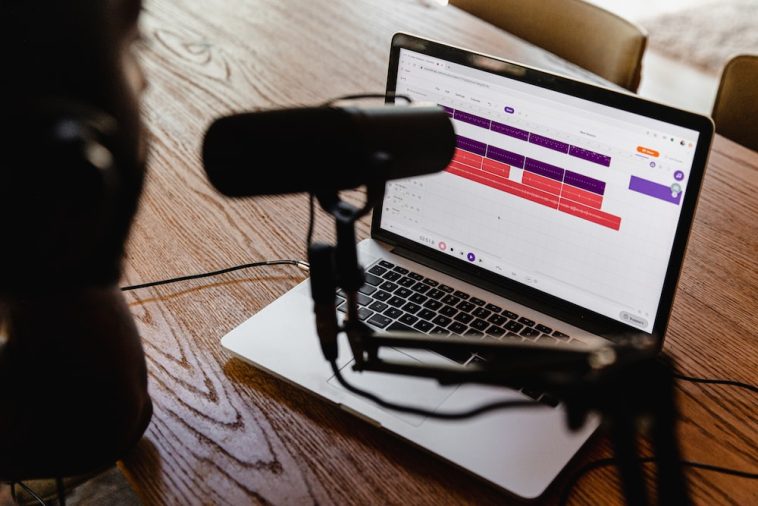Introduction.
In today’s digital landscape, podcasts are not just an audio-only medium. With the increasing popularity of video podcasts, incorporating visual elements into your podcasting strategy can help you engage a wider audience and create a more immersive experience.
One of the key aspects of producing high-quality video podcasts is video editing. Editing your podcast videos allows you to refine the content, enhance the visuals, and deliver a polished final product that captivates your viewers.
In this comprehensive guide, we will delve into the art of video editing for podcasts. Whether you’re a beginner or have some editing experience, these tips and techniques will help you elevate your podcast videos and create a visually appealing and engaging viewing experience.
What Is a Podcast?
A podcast is a digital audio or video program that is typically released in a series of episodes. It is similar to a radio or television show but is available on-demand and can be accessed and downloaded from the internet.
Podcasts cover a wide range of topics, including news, education, entertainment, storytelling, interviews, and more.
Podcasts are designed to be portable and convenient, allowing listeners to enjoy content whenever and wherever they choose.
They can be accessed through dedicated podcasting platforms or apps on smartphones, tablets, or computers. Subscribing to a podcast allows listeners to automatically receive new episodes as they are released.
Podcasts offer a unique form of content consumption. They provide an immersive and intimate experience, often featuring engaging hosts or experts who share their knowledge, perspectives, and stories.
Listeners have the flexibility to listen to podcasts during their commute, while exercising, or during any other activity, making it a popular medium for entertainment and learning.
One of the key features of podcasts is their episodic nature. Shows are typically released on a regular schedule, such as weekly or biweekly, with each episode building upon the previous ones.
This format allows for ongoing narratives, in-depth discussions, or the exploration of a specific theme or subject matter over time.
Podcasts have gained immense popularity in recent years due to their accessibility, diverse range of content, and the ease of creating and distributing them.
They offer a platform for individuals, organizations, and experts to share their expertise, passions, and stories with a global audience. With thousands of podcasts available on various topics, there is something for everyone’s interests and preferences.
Whether you’re looking to stay informed, be entertained, learn something new, or simply enjoy engaging conversations, podcasts provide a rich and engaging medium for audio or video content.
So grab your headphones, subscribe to your favourite podcasts, and embark on an exciting journey of audio storytelling and knowledge exploration.
Why Should I Start a Podcast?
Podcasting has experienced a remarkable surge in popularity in recent years, and it’s not difficult to see why.
With millions of people tuning in to podcasts daily, this medium offers unique opportunities for both creators and listeners.
If you’ve been contemplating whether to start a podcast of your own, here are compelling reasons why you should take the leap and embark on this exciting audio adventure.
1. Share Your Passion and Expertise.
Podcasts provide a platform for you to share your knowledge, insights, and experiences with the world.
Whether you’re an expert in a particular field, a hobbyist with a deep passion, or someone with a unique perspective to offer, podcasting allows you to engage with an audience that shares your interests.
It’s an excellent opportunity to showcase your expertise, build credibility, and connect with like-minded individuals.
2. Build a Community.
Podcasts have a remarkable ability to create communities around shared interests. By starting a podcast, you have the opportunity to bring people together, foster meaningful discussions, and establish connections with your audience.
Your podcast can become a gathering place for people who resonate with your message, creating a supportive and engaged community that extends beyond the audio content.
3. Amplify Your Voice.
In a world saturated with information, podcasting allows you to stand out and be heard. You have the freedom to express your thoughts, ideas, and opinions in your authentic voice.
Whether you want to entertain, educate, inspire, or challenge the status quo, podcasting gives you a powerful platform to communicate with a wide audience and have a meaningful impact on their lives.
4. Explore Creative Expression.
Podcasts offer creative freedom and flexibility. You can experiment with different formats, storytelling techniques, and production styles to create a unique and captivating audio experience.
Whether it’s through interviews, solo episodes, narrative storytelling, or panel discussions, you have the creative control to craft a podcast that reflects your vision and resonates with your audience.
5. Learn and Grow.
Hosting a podcast is not just about sharing your knowledge; it’s also an opportunity for personal growth and continuous learning.
Through research, interviews, and conversations with guests or co-hosts, you’ll expand your knowledge, deepen your understanding of various topics, and develop valuable communication and interviewing skills. Podcasting can be a journey of self-discovery and personal development.
6. Monetization Potential.
While not the primary motivation for starting a podcast, it’s worth mentioning that podcasts offer monetization opportunities.
As your podcast grows in popularity and attracts a dedicated audience, you can explore avenues such as sponsorships, advertising, merchandise sales, crowdfunding, or even creating premium content or courses.
While it requires dedication and consistent effort, podcasting can potentially become a source of income or open doors to other opportunities.
7. Join a Thriving Medium.
Podcasting is a thriving medium with a diverse and engaged listener base. By entering this space, you become part of a vibrant community of podcasters and listeners, with countless opportunities for collaboration, networking, and cross-promotion.
Podcasting offers a unique blend of intimacy, convenience, and storytelling that has captured the attention of millions worldwide.
8. Expand Your Network.
Podcasting opens doors to connect with a diverse range of individuals within your industry or niche. Through interviews, collaborations, and networking opportunities, you can build relationships with experts, thought leaders, and influencers.
These connections can lead to exciting opportunities for growth, exposure, and even partnerships that extend beyond your podcast.
9. Develop Communication Skills.
Hosting a podcast is an excellent way to enhance your communication skills. As you navigate conversations, conduct interviews, and engage with your audience, you’ll develop the art of active listening, effective questioning, and articulating your thoughts clearly.
These skills are valuable not only for podcasting but also for various aspects of personal and professional life.
10. Leave a Lasting Legacy.
Podcasts have the unique quality of leaving a lasting legacy. By recording your thoughts, experiences, and insights, you create a digital archive of your voice and ideas.
Your podcast becomes a time capsule that can be revisited by your audience and future generations. It’s a powerful way to make a meaningful contribution and leave a lasting impact on the world.
11. Enjoy the Creative Process.
Podcasting is a creative outlet that allows you to unleash your imagination and produce content that resonates with you and your audience.
From brainstorming ideas, scripting episodes, recording, editing, and adding music or sound effects, the entire process can be incredibly fulfilling and enjoyable.
It provides a space for self-expression and creativity that can be a rewarding and satisfying endeavour.
12. Have Fun.
Last but certainly not least, podcasting should be fun! It’s an opportunity to engage in conversations, explore topics you’re passionate about, and connect with others who share your interests.
The joy and fulfilment that come from creating and sharing content can be immensely gratifying. Embrace the journey, embrace the process, and enjoy every moment of your podcasting adventure.
How Do I Edit Video For Podcasts?
Video editing plays a crucial role in refining your podcast recordings, enhancing the visuals, and delivering a polished final product that captures your viewers’ attention.
Whether you’re a beginner or have some editing experience, this comprehensive guide will walk you through the essential steps to edit video for your podcast and create captivating content that resonates with your audience.
Step 1: Select the Right Editing Software
The first step in video editing for your podcast is choosing the right editing software. Consider options like Adobe Premiere Pro, Final Cut Pro, iMovie, or DaVinci Resolve, based on your skill level, budget, and platform compatibility.
Explore the features, user interface, and available resources to make an informed choice.
Step 2: Organize Your Files and Prepare Your Project
Before diving into the editing process, organize your video and audio files to streamline your workflow.
Create a folder structure to store your raw footage, audio tracks, images, graphics, and any additional assets.
Import the necessary files into your editing software and create a new project to keep everything organized.
Step 3: Review and Trim Your Footage.
Review your video footage and identify the sections you want to include in your final podcast episode. Trim out any unnecessary content, such as long pauses, mistakes, or irrelevant discussions.
Maintain a cohesive flow and storytelling structure by arranging the clips in a logical order that aligns with the podcast’s narrative.
Step 4: Enhance the Visuals.
Now it’s time to enhance the visual quality of your podcast video. Adjust the brightness, contrast, and saturation levels to ensure a consistent and professional look across all clips.
Apply colour correction techniques to match the visual tone and create a cohesive aesthetic.
Experiment with effects and transitions to add visual interest and create seamless transitions between segments.
Step 5: Sync and Enhance the Audio.
Audio quality is just as important as visuals in a podcast video. Sync your audio tracks with the corresponding video clips to ensure accurate timing and synchronization.
Clean up the audio by removing background noise, adjusting volume levels, and utilizing audio effects like equalization and compression to enhance clarity and balance.
Step 6: Incorporate Graphics and Visual Elements.
Make your podcast video visually engaging by incorporating graphics and visual elements.
Add lower thirds to introduce guests or display key information. Include relevant images, charts, or infographics to support your discussions or emphasize important points.
Experiment with text overlays, captions, and animations to enhance the viewer’s understanding and engagement.
Step 7: Fine-Tune and Polish.
Once you have edited your video, take the time to fine-tune and polish it for a professional finish. Review the entire video to ensure consistency, accuracy, and flow.
Make any necessary adjustments to audio levels, transitions, or visual effects. Pay attention to details like spelling errors or visual inconsistencies.
Add intro and outro segments with branding elements to create a cohesive identity.
Step 8: Export and Distribute.
After completing the editing process, it’s time to export your final video. Choose the appropriate video format and resolution based on your intended distribution platforms.
Consider compression settings to balance file size and video quality. Once exported, test the video on different devices and platforms to ensure compatibility and a smooth viewing experience.
Conclusion.
Video editing is a crucial step in producing high-quality podcast videos that captivate your audience and deliver an immersive experience.
By selecting the right editing software, organizing your files, reviewing and trimming footage, enhancing visuals and audio, incorporating graphics and visual elements, and fine-tuning your final product, you can create compelling podcast videos that resonate with your viewers.
Embrace the art of video editing, unleash your creativity, and bring your podcast episodes to life in a visually captivating way.





GIPHY App Key not set. Please check settings